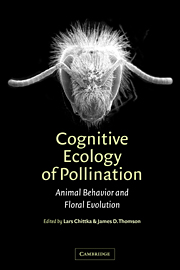Book contents
- Frontmatter
- Contents
- List of contributors
- Preface
- 1 The effect of variation among floral traits on the flower constancy of pollinators
- 2 Behavioral and neural mechanisms of learning and memory as determinants of flower constancy
- 3 Subjective evaluation and choice behavior by nectar-and pollen-collecting bees
- 4 Honeybee vision and floral displays:from detection to close-up recognition
- 5 Floral scent, olfaction, and scent-driven foraging behavior
- 6 Adaptation, constraint, and chance in the evolution of flower color and pollinator color vision
- 7 Foraging and spatial learning in hummingbirds
- 8 Bats as pollinators: foraging energetics and floral adaptations
- 9 Vision and learning in some neglected pollinators: beetles, flies, moths, and butterflies
- 10 Pollinator individuality: when does it matter?
- 11 Effects of predation risk on pollinators and plants
- 12 Pollinator preference, frequency dependence, and floral evolution
- 13 Pollinator-mediated assortative mating: causes and consequences
- 14 Behavioural responses of pollinators to variation in floral display size and their influences on the evolution of floral traits
- 15 The effects of floral design and display on pollinator economics and pollen dispersal
- 16 Pollinator behavior and plant speciation: looking beyond the “ethological isolation” paradigm
- Index
16 - Pollinator behavior and plant speciation: looking beyond the “ethological isolation” paradigm
Published online by Cambridge University Press: 13 August 2009
- Frontmatter
- Contents
- List of contributors
- Preface
- 1 The effect of variation among floral traits on the flower constancy of pollinators
- 2 Behavioral and neural mechanisms of learning and memory as determinants of flower constancy
- 3 Subjective evaluation and choice behavior by nectar-and pollen-collecting bees
- 4 Honeybee vision and floral displays:from detection to close-up recognition
- 5 Floral scent, olfaction, and scent-driven foraging behavior
- 6 Adaptation, constraint, and chance in the evolution of flower color and pollinator color vision
- 7 Foraging and spatial learning in hummingbirds
- 8 Bats as pollinators: foraging energetics and floral adaptations
- 9 Vision and learning in some neglected pollinators: beetles, flies, moths, and butterflies
- 10 Pollinator individuality: when does it matter?
- 11 Effects of predation risk on pollinators and plants
- 12 Pollinator preference, frequency dependence, and floral evolution
- 13 Pollinator-mediated assortative mating: causes and consequences
- 14 Behavioural responses of pollinators to variation in floral display size and their influences on the evolution of floral traits
- 15 The effects of floral design and display on pollinator economics and pollen dispersal
- 16 Pollinator behavior and plant speciation: looking beyond the “ethological isolation” paradigm
- Index
Summary
Floral isolating mechanisms consist of barriers to interspecific pollination in angiosperms imposed by structural contrivances … [and] by the constancy of the pollinators to one kind of flower…
Grant (1949), p 93Ist die Pollen-übertragung durch Insekten geeignet, die zur Artbildung nötige (mechanische) Isolierung zu fördern? (Is pollen transfer by insects suitable for promoting the mechanical isolation needed for speciation?)
Werth (1955), p163Another very obvious deficiency of observations indispensable to be made on the subject … resulted … [from] …the fertilisation of flowers by insects being studied by botanists but little acquainted with insects.
Müller (1873), p 187It often is claimed that Darwin had little to say about the evolution of species, in spite of the title of his 1859 book. This is not strictly true: a close reading of the Origin of Species reveals that Darwin envisioned speciation for the most part as the eventual extension of a process of divergence beginning at a much smaller scale within a single species, and driven for the most part by natural selection. What is true, however, is that a detailed understanding of speciation in its many forms remains an elusive and desirable prize: speciation is, so to speak, the holy grail of evolutionary biology. Many questions confront us still.
- Type
- Chapter
- Information
- Cognitive Ecology of PollinationAnimal Behaviour and Floral Evolution, pp. 318 - 336Publisher: Cambridge University PressPrint publication year: 2001
- 29
- Cited by



